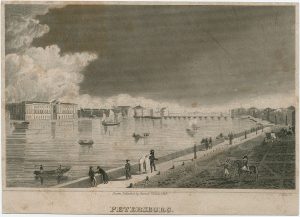By Neal Millikan, Series Editor for Digital Editions
Transcriptions of more than 1,200 pages of John Quincy Adams’s diary have just been added to the John Quincy Adams Digital Diary, a born-digital edition of the Adams Papers editorial project at the Massachusetts Historical Society. The new material spans the period August 1809 through August 1817 and chronicle Adams’s experiences as a diplomat in Russia and Great Britain.
It was with a heavy heart that John Quincy Adams accepted the role of America’s first minister plenipotentiary to Russia. Taking the position would mean traveling with his wife, Louisa Catherine Adams, and his youngest son, Charles Francis Adams, but leaving behind his two eldest sons, George Washington Adams, then age eight, and John Adams, age six, to continue their education in America. Adams, a born diplomat, utilized his new post in St. Petersburg to keep abreast of the shifting European alliances during the Napoleonic Wars. He was on good terms with Emperor Alexander I, and the two men often ran into each other on their walks around the city. During their time in Russia, John Quincy and Louisa Catherine Adams lost their only daughter, also named Louisa Catherine, to dysentery shortly after her first birthday. He agonizingly recounted her illness in his diary, recording that “Her last moments were distressing to me and to her mother, beyond expression.”

When the United States declared war on Great Britain in 1812, owing to issues left unsettled after the Revolutionary War, including the impressment of American sailors, Adams watched from afar. Appointed to lead the peace commission, in April 1814 John Quincy traveled alone to Ghent, Belgium, to help negotiate a settlement with his fellow commissioners and their British counterparts. He noted in his diary: “I commenced my Journey, to contribute if possible to the restoration of Peace to my own Country.” After months of negotiation, a peace agreement was signed on Christmas Eve. As he recorded in his diary on several other occasions throughout his life, John Quincy declared this period in Ghent to be, “the most memorable period of my life.”
Adams next traveled to Paris in January 1815, where he was reacquainted with his wife and youngest son, and then on to Great Britain in May to assume his new role as U.S. minister at the Court of St. James’s. On the 25th, John Quincy had one of the most momentous reunions of his life when he, Louisa, and Charles, were reunited with George and John after almost six years apart. Adams marveled that George had “grown almost out of our knowledge” and noted that John was “yet small for his age.” According to John Quincy, Louisa was “so much overcome by the . . . agitation of meeting so unexpectedly her long absent children, that she was obliged to retire, and twice fainted.” These years in Great Britain were some of the happiest of John Quincy’s adult life; surrounded once again by his entire family, they lived in the aptly named “Little Boston” house in the London suburb of Ealing. Adams traveled into the British capital when necessary for diplomatic work and made many new acquaintances, including the philosopher and social reformer Jeremy Bentham.
John Quincy Adams received notice in April 1817 that President James Monroe had offered him the position of secretary of state. The family sailed for the United States on 15 May and arrived in New York on 6 August. Continuing on to Quincy, on the 18th John Quincy was reunited with “my dear and venerable father and mother,” John and Abigail Adams, recording his “inexpressible happiness” to find them both “in perfect health.”
For more on John Quincy Adams’s life during these years, read the headnote, or, navigate to the entries to begin reading his diary. The addition of material for the 1809–1817 period joins existing transcriptions of Adams’s diary for his early years as a lawyer and diplomat (1789–1801), as secretary of state (1817–1825), and as president (1825–1829), and brings the total number of transcriptions freely available on the MHS website to more than 5,000 pages.
The Adams Papers editorial project at the Massachusetts Historical Society gratefully acknowledges the generous support of our sponsors. Major funding for the John Quincy Adams Digital Diary was provided by the Amelia Peabody Charitable Fund, with additional contributions by Harvard University Press and a number of private donors. The Andrew W. Mellon Foundation in partnership with the National Historical Publications and Records Commission also support the project through funding for the Society’s Primary Source Cooperative.


Very interesting because of the months I worked at the Quincy park
Thank you for your comment. We are so happy you enjoyed the post.
In 1949 I wrote my Master’s thesis at the University of Chicago on “John Quincy Adams Slavery, and the Right of Petition.” In the years since I have maintained my interest in JQA, collecting many books on his life and work. I rejoiced when more historians turned to his life and work, as well as the life of his wife. Having moved into the broader social sciences in my career, my background in history remained the necessary foundation of it all. In my 100th year, I still regard JQA as a major “latter-day” founding father of the nation. Years ago, my wife and I managed to visit the Adams residences; they were a delight to see.
It is so nice to hear from you. Thank you for your comment. There is a lot of information about JQA to explore on our website including the John Quincy Adams Digital Diary (http://www.masshist.org/publications/jqadiaries/index.php). Hopefully these resources will be enjoyed for generations to come.